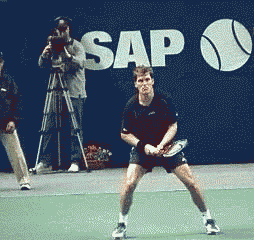|
TennisOne Lessons Winning More Points by Reducing Errors of Depth Howard Brody Since the average player loses many more points due to unforced errors than due to winners hit by an opponent, if the rate of unforced errors can be reduced, it should lead to an increase in points won. In a previous article lateral errors (balls going outside the sideline) were discussed and in this article, errors of depth (balls going long or hitting the net) will be discussed.
In order for a groundstroke to be good it must clear the net and yet not land beyond the baseline. For a given set of initial conditions (ball speed, hitting height, spin, etc) there is a minimum angle for the ball trajectory off of the strings that will just clear the net. For the same initial conditions there is also a maximum ball angle off of the strings that will allow the ball to land within the court. To be a 'good' shot, a ball must be launched between these two angles, and the difference (maximum angle minus minimum angle) is defined as the vertical angular acceptance or the angular window of acceptance. The larger this acceptance window, the more likely it is for a shot to be good and the less likely it will end up being an error. The size of this acceptance window depends on how hard you hit the ball, how much spin you put on it, your location on the court and how high above the ground the ball-racquet impact takes place. If this window is large compared to your own variation in vertical angle from shot-to-shot, you will be known as a 'steady' player. If this window is small or comparable to your shot-to-shot angular variation, you will make lots of errors and lose many of your matches. A computer program has been written which calculates the window size as you vary the initial conditions that are under the control of the player, such as ball speed and spin. Figure 1 shows how the angular window for a flat (no spin) groundstroke varies with initial ball speed if all the other parameters are held constant. From these data it is clear that the harder you hit the ball, the smaller is the window through which the ball must go in order to be a good shot. This is independent of the fact that your shot-to-shot variation in angle may increase as you increase your racquet head speed (some of you may tend to lose some racquet head control when you attempt to hit the ball harder). Ball Speed Figure 1, shows that as the incident ball speed is increased from 50 to 60 mph (which is from 80 to 96 km/hr), the acceptance window shrinks by 43%. If you were to hit the ball even harder and increase your ball speed to 70 mph (112 km/hr), the window will decrease until it is only 1/3 of its original size. This is because the only force that gets a flat (no spin) shot to land in the court is gravity. When you hit the ball hard, gravity has less time to pull the ball down into the court and also the ball has greater resistance to being pulled down. No wonder it is difficult to get those hard shots to land in the court. You are fighting against geometry and Sir Isaac Newton, as well as your opponent. What should you do? Some players want to hit the ball hard and it is more important to do so than to lose points due to making errors. There is no advice for them, because they will not need it. Other players just want to win. This second type of player should reduce their ball speed and by doing so reduce their errors of depth. How much should they reduce their racquet head speed and their ball speed? As the first figure shows, the window keeps getting larger as you reduce the ball speed. However, when your window is considerably larger than your 'spray' (your variation in vertical angle from shot-to-shot) and you are making very few errors of depth, you do not need to slow your shots down any more. Hitting harder does have the advantage that it may cause your opponent to make more errors.
What else can you do to open up your acceptance window, besides not hitting the ball as hard? Hitting the ball when it is higher in its trajectory will increase the window size, but the most effective way is to add topspin, if you can control the shot. The second figure shows how the acceptance window depends on the spin of the ball. Topspin acts like an additional downward force, helping gravity to pull the ball into the court. The more topspin the ball has, the greater the downward force (its called the Magnus Force) and the bigger the window. If topspin is such a great thing, then why does not everyone hit with lots of topspin and why don't we teach beginners to start right off hitting with topspin? When you work out the physics of applying topspin to groundstrokes you discover that you must swing the racquet much harder to get topspin compared to a flat shot and twice as hard when compared to a sliced shot. This is because you are hitting the ball after it has bounced and due to the bounce, the ball acquires a great deal of topspin before it gets to you. To hit with your own topspin, you must not only turn the ball's direction around, but you must also completely reverse its spin direction. This is why you need a much higher racquet head speed to hit with topspin. For many players, this higher racquet head speed is not possible or they lose racquet head control when they try to do it. So they end up hitting flat strokes or even chopping at the ball, which requires the least racquet head speed and the least racquet preparation. Your comments are welcome. Let us know what you think about Howard Brody's article by emailing us here at TennisONE.
Professor Brody is a member the International Tennis Federation Technical Commission, the USTA Sports Science Committee, USTA Technical Committee, science advisor to the Professional Tennis Registry, technical advisor to the United States Racquet Stringers Association, on the Editorial Board of the Journal of Sports Engineering, and on the technical advisory panel of Tennis Magazine. His book Tennis Science for Tennis Players was published by the University of Pennsylvania Press in 1987. He and Vic Braden are featured in a video “The Science and Myths of Tennis.” As one of the principal authors who have written an NSF sponsored high school physics course (Active Physics), he was responsible for the chapters dealing with the physics of sports. He has received the USPTR Plagenhoef award for sports science in 1996 and the International Tennis Hall of Fame Educational Merit Award for the year 2000. His latest book, The Physics and Technology of Tennis, written with Rod Cross and Crawford Lindsey was published in late 2002. He is also one of the principal authors of the CD-ROM on The Science of Tennis funded by the Lawn Tennis Association Coach Education. At the 2003 Tennis Science and Technology Congress, the ITF gave a prize for the best paper presented and named it the “Howard Brody Award” for his service to tennis. |



 Spin
Spin Dr. Howard Brody is an emeritus professor of physics at the University of Pennsylvania , where he was interim varsity tennis coach for part of the 1991 season. He played varsity tennis and earned his bachelor's degree at MIT and his master's and doctoral degrees at Cal Tech. Recently he has been investigating the physics of sports, particularly tennis. He has written many papers and articles on the subject, given numerous lectures and talks on tennis, and done several television programs explaining the science behind tennis, football, and baseball.
Dr. Howard Brody is an emeritus professor of physics at the University of Pennsylvania , where he was interim varsity tennis coach for part of the 1991 season. He played varsity tennis and earned his bachelor's degree at MIT and his master's and doctoral degrees at Cal Tech. Recently he has been investigating the physics of sports, particularly tennis. He has written many papers and articles on the subject, given numerous lectures and talks on tennis, and done several television programs explaining the science behind tennis, football, and baseball.